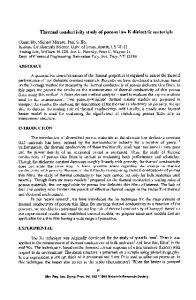Low Dielectric Constant Porous Silsesquioxane Films: Effect of Thermal Treatment
- PDF / 2,068,990 Bytes
- 6 Pages / 612 x 792 pts (letter) Page_size
- 73 Downloads / 296 Views
Low Dielectric Constant Porous Silsesquioxane Films: Effect of Thermal Treatment Y. K. Siew* ,G. Sarkar* ,X. Hu* ,Y. Xu** and A. See** Division of Materials Engineering, School of Applied Science, Nanyang Technological University Nanyang Avenue Singapore 639798 (E-mail: [email protected]) ** R&D Dept. Chartered Semiconductor Manufacturing Ltd., 60 Woodlands Industrial Park D, Street 2, Singapore 738406
*
ABSTRACT Low dielectric constant, nanoporous hydrogen silsesquioxane (HSQ) films were prepared using hybrid templating method by addition of a sacrificial labile polymer, polybutadiene (PB). Thermal gravimetric analyzer (TGA) was employed to monitor the decomposition behavior of HSQ-PB films. Curing of HSQ and decomposition of PB were performed by a two-stage thermal treatment to obtain a defect-free film. The porosity level and pore morphology of the resultant porous films were found to be dependent upon thermal treatment conditions applied. INTRODUCTION As metal pitch of multilevel interconnect continues to shrink, the interconnect RC delay becomes larger than the intrinsic gate delay. To maintain high signal propagation speed in IC devices, it will be mandatory to reduce dielectric constants (k) of intermetal dielectric. When choosing low k materials with k below 3.0, not only are the material properties of great concern, their extendibility to future generations also affects material selection. It is well agreed that only porous materials can deliver the lowest required dielectric constants (k
Data Loading...










